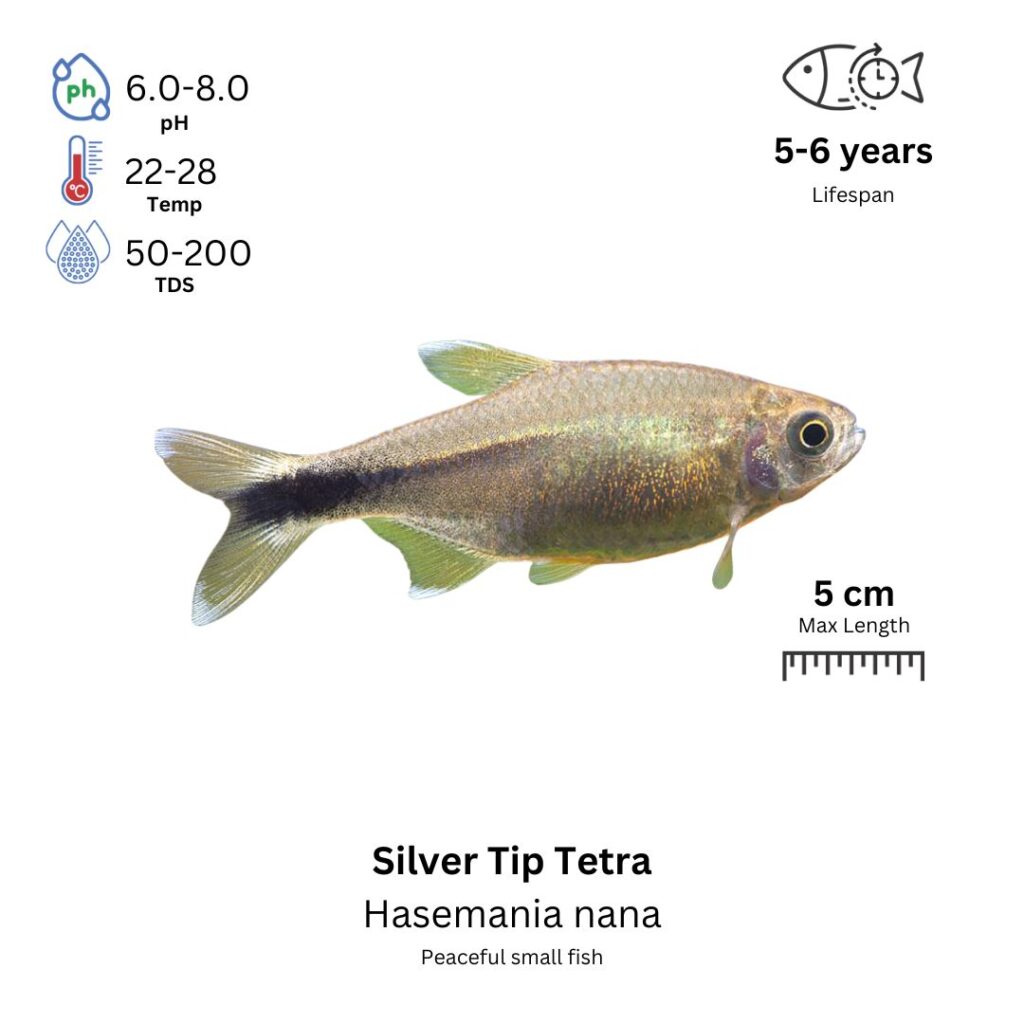Silver Tip Tetra
Hasemania nana

Description
The Silver Tip Tetra is a small, attractive fish known for its striking silver body and vibrant fins. Its body is a shimmering silver color, which makes it stand out in aquariums, especially when caught in the light. The most distinctive feature of the Silver Tip Tetra is the bright golden or yellowish tips on its fins, which contrast nicely against the silver body. These fish are peaceful, active, and social, often seen swimming in schools in the middle or upper parts of the tank. They are generally calm, non-aggressive fish that do well in community setups and can be a great choice for a peaceful aquarium with compatible tankmates.
Habitat Origin
Native to the Amazon and Orinoco river basins in South America, particularly in Brazil and Venezuela, where they are found in slow-moving streams and rivers with plenty of submerged vegetation. They inhabit clear, soft, slightly acidic waters.
Aquarium
Ideal Number in Aquarium: At least 6 individuals, as they are schooling fish and feel more secure in groups.
Favorite Food

Silver Tip Tetras are omnivores and will accept a variety of foods. They can be fed high-quality flake food, micro pellets, and live or frozen foods such as brine shrimp, bloodworms, and daphnia. They also enjoy algae and small plant-based matter, making them suitable for planted tanks.
Behavior:
Silver Tip Tetras are peaceful and social fish that do best when kept in schools of at least 6 individuals. They are active swimmers and can often be found darting through the middle and upper regions of the tank. They are non-aggressive and generally do not compete for food or territory, making them ideal for community tanks. Due to their schooling nature, they feel most comfortable and exhibit their natural behavior when housed in groups.
Special Care:
These tetras thrive in well-planted tanks with plenty of hiding spots such as driftwood, rocks, and plants. Regular water changes and good filtration are essential to maintain stable water conditions, as they are sensitive to water quality. Silver Tip Tetras prefer soft, slightly acidic water, which mirrors their natural habitat. A moderate flow of water is ideal, as they are accustomed to calm, flowing waters.
Compatibility with Other Fish:
Yes, Silver Tip Tetras are great tankmates for other peaceful fish such as other tetras, rasboras, small catfish, and shrimp. They should not be kept with aggressive or larger species, as their peaceful nature makes them vulnerable to bullying. Due to their schooling behavior, they do best in tanks with other species that have similar water and temperament requirements.
Breeding Tank Setup
A separate breeding tank is highly recommended for Silver Tip Tetras to improve egg survival and control water parameters. A 10-gallon (38-liter) tank is sufficient for a breeding pair or small group, while a 20-gallon (75-liter) setup is better for multiple pairs. Maintain a pH of 6.0–7.5, temperature between 24–28°C (75–82°F), and water hardness of 2–12 dGH. Use fine gravel or sand and add live plants such as Java moss and Hornwort, as well as floating plants like Water Sprite to offer cover and egg attachment sites. A sponge filter or gentle internal filter will help keep the water clean without disturbing the eggs.
Conditioning for Breeding
To condition Silver Tip Tetras for spawning, feed them a rich and varied diet. Use high-quality flakes or micro pellets, supplemented with live or frozen foods like brine shrimp, bloodworms, and daphnia. Add vegetable-based foods like chopped spinach or peas for balance. Perform 20–30% weekly water changes to maintain quality, and to trigger breeding, do a 50% water change with a slight temperature increase to 28°C (82°F) to simulate rainy-season conditions that naturally stimulate spawning.
Spawning Process
Spawning generally occurs in the early morning, often triggered by environmental cues. Males display bright fins and vibrant coloration, actively chasing females. The female scatters 30–100 small, sticky eggs across the tank, which attach to plants and decor. Since Silver Tip Tetras may eat their own eggs, it is important to remove the parents immediately after spawning to protect the eggs and maximize hatching success.
Fry Development & Care
Eggs hatch in 24–36 hours, depending on temperature. Newly hatched fry rely on yolk sacs for nourishment during the first few days. Afterward, feed them infusoria or liquid fry food, followed by baby brine shrimp, microworms, or crushed flakes as they grow. Keep the environment clean with small, frequent water changes (10–20%) daily or every other day. Avoid overfeeding to prevent water pollution, and maintain stable conditions in the 24–28°C range.
Maturity, Sexing & Stress Prevention
Silver Tip Tetras are ready to breed at 6–12 months of age. Males are smaller and more colorful, especially during breeding season, while females are fuller-bodied and less vibrant. To ensure successful breeding, avoid sudden shifts in water conditions and maintain a peaceful tank environment. Regular maintenance, proper nutrition, and stress-free surroundings are key to promoting healthy breeding behavior and fry development.
